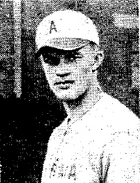Hugh Bedient, Jr.
| Date and Place of Birth: | October 13, 1916 Falconer, NY |
| Date and Place of Death: | June 17, 1940 Bellerose Manor, Queens, NY |
| Baseball Experience: | Minor League |
| Position: | Pitcher |
| Rank: | Second Lieutenant |
| Military Unit: | 5th Squadron, 9th Bomb Group, 2nd Wing US Army Air Corps |
| Area Served: | United States |
In 1908, Hugh Bedient (father of Hugh P. Bedient, Jr.) struck out 42
batters in a 23-inning semi-pro game in Falconer, New York. This
unparalled iron-man feat attracted the attention of professional scouts
and he signed with the Boston Red Sox organization in 1910. In his
rookie season at Fenway Park in 1912, Bedient won 20 games against just
nine losses and remained in the major leagues until developing a sore
arm following the 1915 season.
Bedient was pitching for the aptly named Toledo Iron Men of the American
Association, when his son, Hugh, Jr., was born in 1916. A tall,
hard-throwing right-hander, Hugh Bedient, Jr., starred in baseball and
basketball at Falconer High School, New York, pitching five no-hitters
before graduating in 1933. He also played three years with the Jamestown
nine in the American Legion series, with his team winning the state
championship two of the three years.
He then enrolled at St. Lawrence University in Canton, New York, and
attracted much attention from baseball scouts after he transferred to
the University of Alabama. Bedient had three wins without a defeat for
the Crimson Tide freshmen in 1935, and became the varsity team’s most
dominant pitcher over the next three seasons. During the summer months,
he also pitched in the Dixie Amateur League as he eyed a career in the
professional game.
"The strong right arm of sophomore Hugh Bedient may some day hurl a baseball over the plate with the speed and deception his dad used back in 1912 to whip Christy Mathewson in two games and win the World Series for the Boston Red Sox," declared an Associated Press article on March 15, 1936.
"He shows signs of developing into professional timber," Alabama coach Tilden 'Happy' Chandler told the Associated Press. "He certainly has the physical qualifications."
Bedient gave his father credit for his success as a college hurler. "He used to give me tips on delivery and form," he recalled in 1937. "He wants me to be a big league pitcher."
Bedient wanted to be one too, but he wasn't building up his hopes. "I know what it takes to get you there," he said, "and if I've got it then everything will be fine. If I haven't . . . then I'm going to try to be a sports writer."
Following graduation in June 1938, Bedient signed with the Boston Braves
and joined the Evansville Bees of the Class B Three-I League in July. On
July 6, he made his professional debut against the Clinton Owls at
Evansville’s Bosse Field, allowing just four hits and one run before
being relieved by Charlie Frye in the eighth. He also contributed a
single and a double to his first professional win. But it was to be a
short-lived career. Bedient made just two further unsuccessful
appearances for the Bees before injuries brought his playing career to
an end.
On June 28, 1939, the 23-year-old turned his back on any hopes of making a
return to baseball and enlisted with the Army Air Corps; the decision
was possibly influenced by the University of Alabama’s extremely popular
aeronautical engineering department. He first attended elementary flying
school at Randolph Field, Texas, and then earned a commission as a
second lieutenant at Kelly Field, Texas. Shortly afterwards, he was
assigned to the Air Defense Command at Mitchel Field, Long Island, New
York, with his living quarters at Madison Barracks, Sackets Harbor, New
York. On May 4, 1940, Bedient married Jimmy Lee Malone of Anniston,
Alabama, at Fort Lauderdale, Florida.
Six weeks later, on Sunday, June 16, 1940, Bedient sent his parents a telegram stating
that he was spending the day with his wife at Great Neck. The following
day, at around 9:00
A.M. on Monday, June 17, two twin-engined Douglas B-18 Bolo bombers,
escorted by two fighter planes, left Mitchel Field on a routine training
flight. The two bombers carried a crew of 11, including Second
Lieutenant Bedient. Just 15 miles from Mitchel Field, above the densely
populated area of Bellerose Manor on the eastern edge of Queens, New
York, the two bombers were executing a maneuver at 2,500 feet. One plane
had to pass under the other and there was not enough clearance. The two
planes collided and crashed in flames. One landed within a block of a
school and the second smashed into a one-story residence that instantly
went up in flames. All 11 crewmen — two of whom unsuccessfully attempted
to escape by parachute — perished in the wreckage.
F.W. Watkins, whose home was within 50 yards of the scene of the crash,
was sitting in his living room when the planes came down. "I ran outside
immediately, and two houses directly across the street, which were hit
by wreckage, were already blazing fiercely. It seemed only a few minutes
before rescue squads arrived and the bodies were being dragged from the
wreckage. At short intervals there were explosions which sounded as
though small bombs were going off."[1]
The loss of life on the ground was miraculously low. The only civilian
fatality was 35-year-old Emily Kraft, who suffered severe burns when her
home was set on fire. She died at the Queens General Hospital the
following day.
Funeral services were held for Hugh P. Bedient, Jr., at Falconer Funeral
Home and at Levant Cemetery in Poland, New York. Members of the Henry
Mosher post, American Legion of Falconer, formed the guard of honor,
while Reverand Harold L. Knappenberger officiated at the funeral home
and Reverand R.W. Neathery was the graveside chaplain.
|
Year |
Team |
League |
Class |
G |
IP |
ER |
BB |
SO |
W |
L |
ERA |
|
1938 |
Evansville |
Three-I |
B |
3 |
10 |
- |
10 |
4 |
1 |
0 |
- |
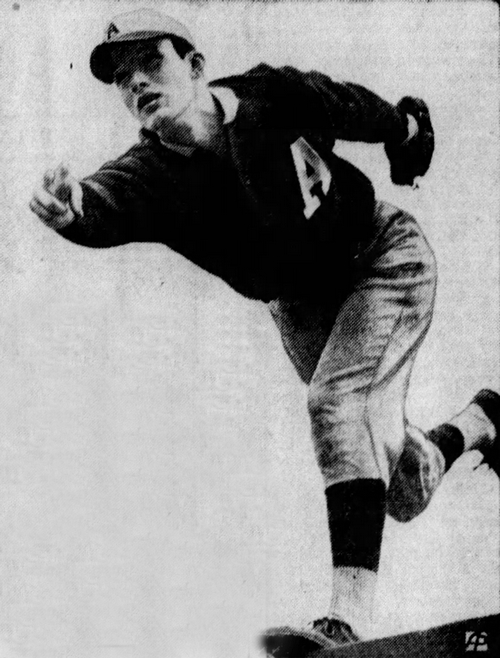
Hugh Bedient Jr. at the University of Alabama
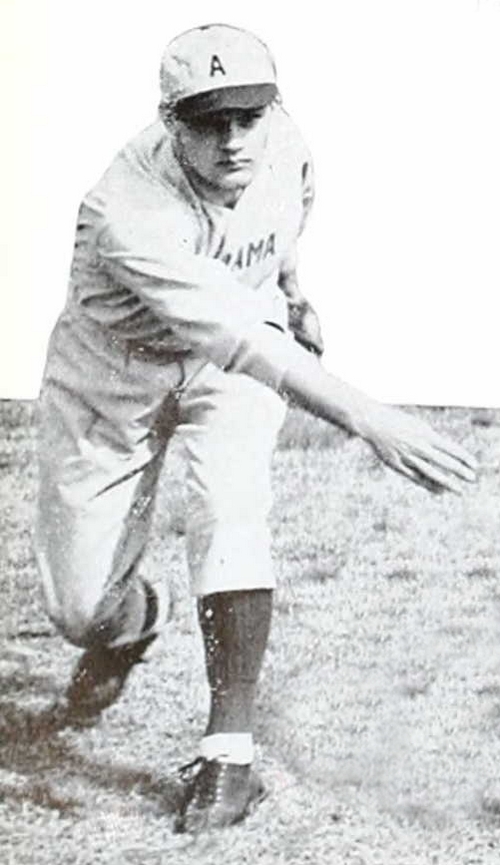
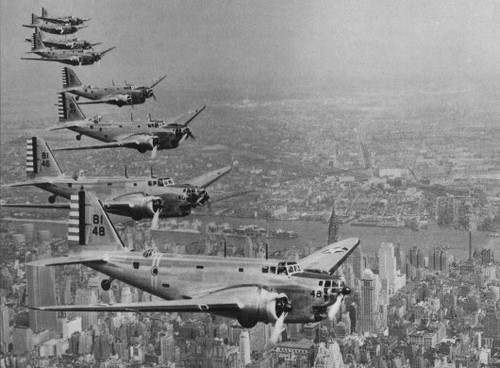
Douglas B-18 Bolo bombers. The type flown by Hugh P. Bedient, Jr.
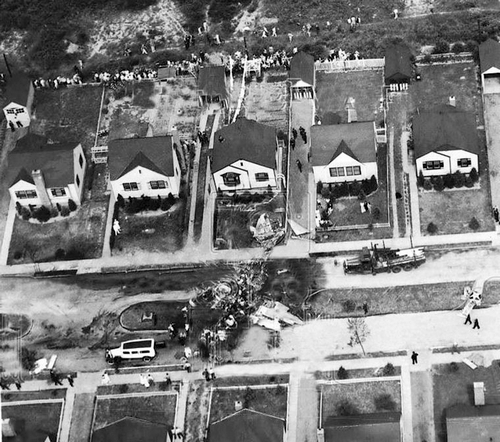
The scene at 239th Street south of Hillside Avenue in Bellerose Manor shortly after the plane crash of June 17, 1940.
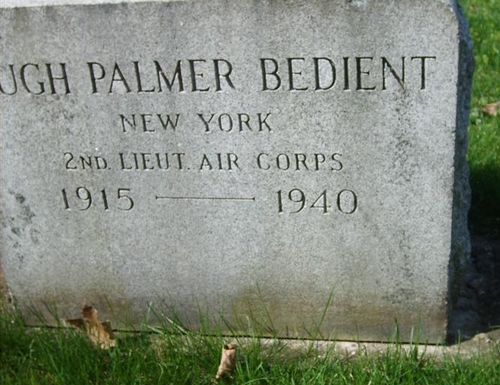
Hugh Bedient, Jr's., grave at Levant Cemetery in Poland, New York
Notes
1. Dunkirk Evening Observer, June 17, 1940.
Thanks to Astrid van Erp for help with photos and information for this biography
Date Added: January 23, 2012 Updated August 2, 2017
Baseball's Greatest Sacrifice is associated with Baseball Almanac
Baseball's Greatest Sacrifice is proud to be sponsored by

